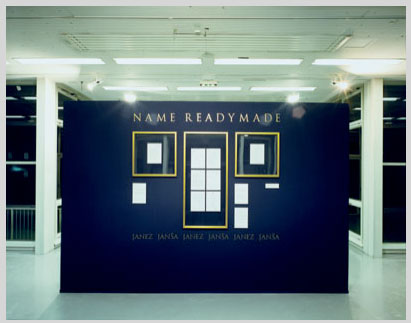
Janez Jansa, Janez Jansa, Janez Jansa
NAME Readymade
Thursday May 7, 2009 at 7 pm
Free and open to the public
Can you imagine a few years ago 3 established American artists joining the Republican Party and then legally changing their names to George W. Bush? And since then bringing the name of the USA President to museums, exhibiting next to Robert Gober or Barbara Kruger, festivals, showing work next to Meg Stuart and Nature Theater of Oklahoma, galleries, presenting video alongside Bruce Nauman?
Location One is glad to invite you to NAME Readymade, the presentation of the "Name changing" gesture perpetrated by three Slovenian artists who, in 2007 officially changed their names to the Slovenia's economic-liberal, conservative prime minister at the time, Janez Jansa.
"When the three artists changed their names to Janez Jansa, they in fact adopted a critical stand to the state. To the Slovene government, in which until recently all posts seemed occupied as it were by a single person - Janez Jansa. [...] Through the multiplication of Janez Jansa's name, the function of the prime minister has assumed, within this specific artistic action, a similar position as the Campbell soup cans in Andy Warhol's works." (Zdenka Badovinac, Name Readymade, October 2008)
All Janez Jansas' works, their private and public affairs, in a word their whole life has been conducted under this name ever since.
Janez Jansa at Location One will take you through a series of artistic, political, administrative and media actions performed by himself together with Janez Jansa and Janez Jansa with a particular focus on their latest personal exhibition entitled NAME Readymade.
Works exhibited in this show (valid ID cards, passports, credit and bank cards, driving licences, birth and marriage certificates, and so on) are generated by the reality itself.
"The use of personal documents as exhibition items is certainly a liminal case; it probes certain boundaries. It is liminal in that it is not clear whether or not such a use of personal documents respects the rights that you acquired when you were issued these documents. You cannot burn documents as this is a criminal offence, but what about the use of documents for artistic purposes? To be sure, this is not something that serious people would use to justify persecution in the name of the state; yet, this does mean that everybody knows that you are not carrying your documents, that is, that you are not using them in compliance with the conditions under which they were issued to you. Even a bank can cancel your cards if they find out that you are using them in an inappropriate way. You are walking a line that I would not call "dangerous", but I do, however, consider it suspicious. This is precisely part of the risk that I mentioned before. Here, we can see various things that could develop from this. After all, you have to make a special effort to find out how security is going to work at the exhibition. It is an entirely different thing if you exhibit graphics numbered 1 to 100 that are insured through an insurance company. I doubt that an insurance company would issue an insurance policy for the everyday functional value of the exhibited documents in the same way as they would issue tourist insurance - such insurance would require the issuance of new documents. Furthermore, it is also interesting that these documents are art works, readymades. The original of Fountain has been lost, nicked, so Duchamp made new ones, signed them anew, he even made a miniature version for his little suitcase; you, however, cannot make new documents, they can only be made by an authorized organization called the state and its Ministry of Internal Affairs. Yet the Ministry itself cannot function illegally and, for example, reproduce these documents as art works. Now what? These are works of art only insofar as they are also authentic documents. Here we reach a contradiction - the very contradiction of the world of art. A readymade as a work of art is something inauthentic; it is the proof of inauthenticity: with a readymade, the "aura" disappears. In your case, however, the precondition for this readymade is its authenticity in everyday life - its credibility and authenticity. If somebody bought this work of art, they would be buying it as authenticity, together with its functional "readymade" value."
(Lev Kreft, Name as Readymade, An interview with Janez Jansa, Janez Jansa
and Janez Jansa, NAME Readymade, October 2008)
Janez Jansa, Janez Jansa and Janez Jansa cut right in the midst of their own realities and the reality of the space and time, in which they work. For this purpose they used procedures typical for art - transformation, translation, representation and mimicry. They turned around the classical relational scheme between art and life as it was developed in the 20th century. Art in previous century is redefined by way of reality entering into artistic contexts without mediation (so that Badiou can define the 20th century as the passion for the real), while Jansa, Jansa and Jansa want to achieve the opposite so that their methods cut deeply into their material lives and the lives of their immediate surrounding.
Project supported by the Ministry of Culture of the Republic of Slovenia and the Municipality of Ljubljana.
http://www.aksioma.org/name



